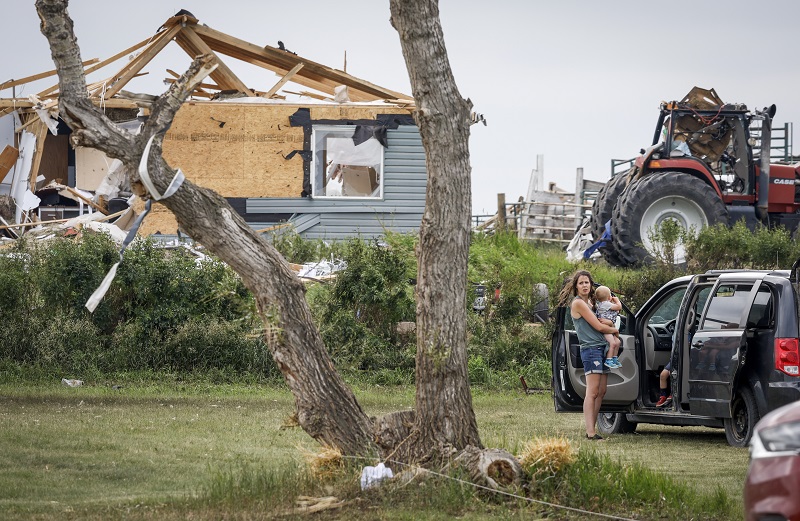Will powerful Alberta tornado be declared a Cat?

A powerful Canada Day tornado that swept through a section of rural Alberta likely won’t result in much insured damage despite strong winds that reached an estimated 275 km/h.
The EF4 tornado tore through an area south of Didsbury, Alta. on July 1, destroying three homes, leaving four uninhabitable and damaging another five, according to the Northern Tornadoes Project (NTP) at Western University in London, Ont.
Some farm buildings, farm equipment and vehicles were also hit, added Glenn McGillivray, managing director of the Institute for Catastrophic Loss Reduction (ICLR).
“We did see a few claims come in from the tornado,” Lewis Moorman, vice president of Western Canada with ClaimsPro told Canadian Underwriter Thursday. “It hit a rural area consisting mostly of farmland so the property damage was not as severe as it could have otherwise been. The files that we received were residential in nature, and there was destruction to those properties affected.
“This could have been much worse had the tornado hit a more populated area.”
Patricia (P.J.) Davis, national Cat manager with Crawford & Company Canada also pointed to the several properties that were destroyed or severely damaged. “Residents did react quickly to seek shelter and thankfully there were no serious injuries,” she said. “As the impacted area was rural, the overall volume of claims received was minimal.”
The event may not count as an “official” Cat by Catastrophe Indices and Quantification Inc. (CatIQ), as the loss may not exceed $30 million, McGillivray suggested.
“Perhaps it will go down as a ‘notable event,’” he said, adding that in Canada, tornadoes have yet to cause really significant insured damage in Canada, unlike in the U.S., where there have been USD $billion-plus events. “The July 2021 tornado in Barrie, Ontario led to insured damage of about $100 million, largely because it struck a built-up area.”
Vehicles sit amidst a tornado damaged home near Carstairs, Alta., Saturday, July 1, 2023. No injuries were reported. THE CANADIAN PRESS/Jeff McIntosh
In Alberta, the tornado developed southwest of Didsbury and tracked eastward to north of Carstairs, with a preliminary path length of 15.3 km and a maximum path width of 620 metres, NTP reported.
Various farm equipment was flipped and thrown, including a nearly 10,000 kg combine that was tossed at least 50 m, and then rolled for another 50m to 100m, NTP said. Notable tree damage occurred, and power poles, crops and vehicles were also damaged.
There was only one minor injury to a first responder, but several dozen farm animals were killed.
The tornado was the strongest recorded in Alberta since an F4 tornado hit Edmonton in 1987 (F stands for Fujita Scale, while EF refers to the Enhanced Fujita Scale, introduced in Canada in 2013). It was also one of only three tornadoes rated F/EF4 in Alberta (the other hit the Grassy Lake area in 1915).
There have only been two tornadoes rated EF4 since the scale was implemented in 2013 — the recent Didsbury tornado and one in Alonsa, Man. in 2018, also with a maximum wind speed of 275 km/h.
Since the 1900s, there have only been 21 F4/EF4 tornadoes across the country, McGillivray added. Twelve were in southern Ontario, according to NTP, while Saskatchewan and Manitoba experienced several F4 tornadoes (three in Saskatchewan, all before 1920, and two in Manitoba between 1977 and 1994).
“Ninety-five per cent of tornadoes in Canada rank in the EF0 to EF3 range, with the vast majority being EF0 and EF1,” McGillivray told CU. “As you go up in ranking, they become rarer…
“There has only been one F5 ever recorded in Canada, in Elie, Manitoba in 2007.”
When asked what precautions homeowners can take and if damage from EF4 winds (between 270 km/h and 310 km/h) can be prevented, McGillivray said the science indicates new homes can be built to withstand up to EF2 with relatively cheap features that aren’t difficult to add in at the new construction phase.
“Above EF2, we would be talking about really reinforced construction and ICLR does not advocate for this,” McGillivray said. “EF3 to EF5 tornadoes are quite rare in Canada and building for them would not make much economic sense.”
It’s important to note that in EF3-EF5 tornadoes, only portions of the tornado track have those high-speed winds.
“So, by building for up to an EF2 tornado, you not only build for the majority of tornadoes in Canada, but you also build for parts of stronger storms too,” McGillivray said. “At higher rankings, we are more concerned with life safety than reducing property damage, so people need to know what to do to protect themselves, like getting into basements or windowless rooms, etc.”
ICLR is often asked about tornadoes and climate change, and whether tornadoes are changing in Canada, McGillivray added. Officially, Canada sees about 60 tornadoes a year, but NTP has identified more tornadoes (117 in 2022).
“We don’t have a good understanding of what ‘normal’ is in Canada,” he said. “Until we know the true tornado climatology for Canada, it will not be possible to tell whether tornado patterns are changing here.”
Feature image: A tornado damaged home is seen near Carstairs, Alta., Saturday, July 1, 2023. No injuries were reported. THE CANADIAN PRESS/Jeff McIntosh







